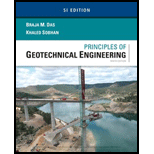
Find the Rankine active force
Answer to Problem 13.19P
The Rankine active force
The location
Explanation of Solution
Given information:
The height (H) of the retaining wall is 12 m.
The depth
The unit weight
The sand friction angle
The cohesion
The surcharge pressure (q) is
The depth
The saturated unit weight
The saturated sand friction angle
The cohesion
Calculation:
For sand:
Determine the active earth pressure coefficient
Substitute
For saturated sand:
Determine the active earth pressure coefficient
Substitute
Determine the total stress
Substitute
Determine the pore water pressure at 0 m depth using the relation.
Here,
Take the unit weight of the water as
Substitute
Determine the effective active earth pressure
Substitute
Determine the total stress (sand)
Substitute
Determine the total stress (saturated sand)
Substitute
Determine the pore water pressure at 3.0 m depth using the relation.
Substitute
Determine the effective active earth pressure (sand)
Substitute
Determine the effective active earth pressure (saturated sand)
Substitute
Determine the total stress
Substitute
Determine the pore water pressure at 8 m depth using the relation.
Substitute
Determine the effective active earth pressure
Substitute
Show the variation of effective active earth pressure and pore water pressure for the respective depth as in Figure 1.

Refer Figure 1.
Determine the active earth pressure per unit length for area 1 using the relation.
Here, b is the width and h is the depth.
Substitute
Determine the active earth pressure per unit length for area 2 using the relation.
Substitute
Determine the active earth pressure per unit length for area 3 using the relation.
Substitute 8.0 m for b and
Determine the active earth pressure per unit length for area 4 using the relation.
Substitute 8.0 m for b and
Determine the active earth pressure per unit length for area 5 using the relation.
Substitute 8.0 m for b and
Determine the Rankine active force
Substitute
Thus, the Rankine active force
Determine the location
Substitute
Thus, the location of the resultant force is
Want to see more full solutions like this?
Chapter 13 Solutions
EBK PRINCIPLES OF GEOTECHNICAL ENGINEER
- 6000 units have been installed to date with 9,000 units to install. Labor costs are $23,300.00 to date. What is the unit cost for labor to date?arrow_forwardThe base rate for labor is $15/hr. The labor burden is 35% and 3% for small tools for the labor. There are 1000 units to install. Records indicate that trade workers can install 10 units per hour, per trade worker. The owners need 15% overhead and profit to pay bills, pay interest on loan and provide some profit to the partners. What is the minimum bid assuming no risk avoidance factor?arrow_forwardCan you show me how to obtain these answers thanks, will rate!arrow_forward
- I have the answers for part a just need help with b mostly thanksarrow_forwardPlease explain step by step and show formulasarrow_forward5. (20 Points) Consider a channel width change in the same 7-foot wide rectangular in Problem 4. The horizontal channel narrows as depicted below. The flow rate is 90 cfs, and the energy loss (headloss) through the transition is 0.05 feet. The water depth at the entrance to the transition is initially 4'. 1 b₁ TOTAL ENERGY LINE V² 129 У1 I b₂ TOP VIEW 2 PROFILE VIEW h₁ = 0.05 EGL Y₂ = ? a) b) c) 2 Determine the width, b₂ that will cause a choke at location 2. Determine the water depth at the downstream end of the channel transition (y₂) section if b₂ = 5 feet. Calculate the change in water level after the transition. Plot the specific energy diagram showing all key points. Provide printout in homework. d) What will occur if b₂ = = 1.5 ft.?arrow_forward
- 4. (20 Points) A transition section has been proposed to raise the bed level a height Dz in a 7-foot wide rectangular channel. The design flow rate in the channel is 90 cfs, and the energy loss (headloss) through the transition is 0.05 feet. The water depth at the entrance to the transition section is initially 4 feet. b₁ = b = b2 1 TOTAL ENERGY LINE V² 129 Ут TOP VIEW 2 hloss = 0.05 " EGL Y₂ = ? PROFILE VIEW a) Determine the minimum bed level rise, Dz, which will choke the flow. b) If the step height, Dz = 1 ft, determine the water depth (y2) at the downstream end of the channel transition section. Calculate the amount the water level drops or rises over the step. c) Plot the specific energy diagram showing all key points. Provide printout in Bework. d) What will occur if Dz = 3.0 ft.?. Crest Front Viewarrow_forward1. (20 Points) Determine the critical depth in the trapezoidal drainage ditch shown below. The slope of the ditch is 0.0016, the side slopes are 1V:2.5H, the bottom width is b = 14', and the design discharge is 500 cfs. At this discharge the depth is y = 4.25'. Also, determine the flow regime and calculate the Froude number. Ye= ? Z barrow_forward3. (20 Points) A broad crested weir, 10 feet high, will be constructed in a rectangular channel B feet wide. The weir crest extends a length of B = 120 feet between the banks with 2 - 4 foot wide, round nosed piers in the channel. The width of the weir crest is 8 feet. If H = 6', determine the design discharge for the weir.arrow_forward
 Principles of Geotechnical Engineering (MindTap C...Civil EngineeringISBN:9781305970939Author:Braja M. Das, Khaled SobhanPublisher:Cengage Learning
Principles of Geotechnical Engineering (MindTap C...Civil EngineeringISBN:9781305970939Author:Braja M. Das, Khaled SobhanPublisher:Cengage Learning Principles of Foundation Engineering (MindTap Cou...Civil EngineeringISBN:9781337705028Author:Braja M. Das, Nagaratnam SivakuganPublisher:Cengage Learning
Principles of Foundation Engineering (MindTap Cou...Civil EngineeringISBN:9781337705028Author:Braja M. Das, Nagaratnam SivakuganPublisher:Cengage Learning Fundamentals of Geotechnical Engineering (MindTap...Civil EngineeringISBN:9781305635180Author:Braja M. Das, Nagaratnam SivakuganPublisher:Cengage Learning
Fundamentals of Geotechnical Engineering (MindTap...Civil EngineeringISBN:9781305635180Author:Braja M. Das, Nagaratnam SivakuganPublisher:Cengage Learning Principles of Foundation Engineering (MindTap Cou...Civil EngineeringISBN:9781305081550Author:Braja M. DasPublisher:Cengage Learning
Principles of Foundation Engineering (MindTap Cou...Civil EngineeringISBN:9781305081550Author:Braja M. DasPublisher:Cengage Learning



